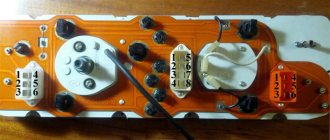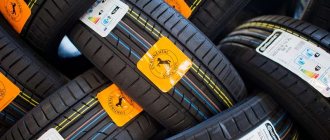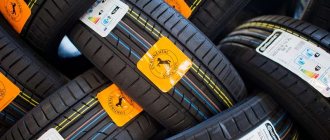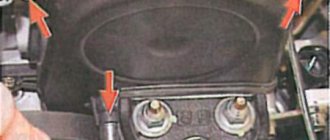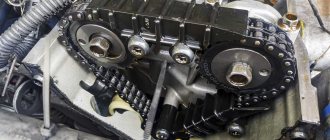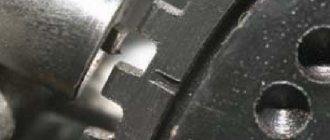Hello, dear readers! You probably know that springs play a huge role in the suspension system of any vehicle and perform several functions. If you choose them correctly, the car will be easier to drive, its load capacity will increase, you will be able to comfortably overcome road irregularities, etc. At the same time, many are confused by the marks on the springs.
Not everyone understands what these traces of paint mean, what they are like and why they differ from each other in color.
Someone will confidently say that in this way the manufacturer classifies the springs by stiffness and the color largely reflects the characteristics of the product. And they will be absolutely right.
I propose to understand in detail what these color markings are, why they are colored and how they differ from each other. If you have anything to add, be sure to write in the comments. Perhaps I will miss some important points.
Spring stiffness classes
Each spring sample is assigned a specific class before leaving the factory. Thus, class “A” is assigned to springs that fall within the upper tolerance range, and class “B” to springs whose height is close to the lower tolerance range.
- Class “A” is assigned the following color markers of spring stiffness - white, yellow, orange and brown.
- Class “B” - black, blue, light blue and yellow color markings for springs.
Recommendations for choosing springs
Springs of the same class are always installed on a car so that the car does not lose the elastic properties of the suspension and handling. It is also not recommended to install springs of different classes in front and behind the car. This will lead to imbalance of the car at high speeds and when cornering. If there is such a need, then it is allowed to install class “A” springs in the front suspension, and class “B” springs in the rear.
For crossovers and off-road vehicles, class “A” springs are often installed. They withstand slightly greater loads and have a longer stroke compared to class “B”.
Don't neglect buying more expensive springs, higher class springs. Both the car’s suspension and your condition will thank you on a long, long trip. A softer ride will reduce vibration loads on the driver, which often lead to rapid fatigue and decreased concentration.
When replacing springs on a vehicle, you have the right to choose any model in terms of stiffness, depending on your operating conditions and use of the car. GOSTs do not describe the mandatory installation of only original shock absorbers and springs! You must understand that hard springs have a big difference in parameters from standard ones, because... the process of making them is somewhat different. Also, the buyer is not prohibited from installing different Russian or imported power springs on the front and rear axles.
Resource experiments prove the processes of device wear - shock absorbers burst, wear out, allow the body to sway, cannot be restored and reduce the mechanical life according to a proportional linear schedule.
Main varieties
Before we begin to consider the types of springs for cars, let’s briefly remember why they are needed.
When moving over uneven surfaces, the car should remain soft. Otherwise, the trip will be no different from traveling by cart. To ensure comfort, automakers equip vehicles with suspension. In fact, comfort when using the suspension is an added bonus. The primary purpose of springs in a car is transport safety. When a wheel hits an obstacle at speed, such as a bump, the shock absorber softens the impact. However, to prevent the car from losing traction with the road surface, the wheel must be quickly returned to a hard surface.
Color coding of "Sport" springs
With sport springs, color does not matter and is the company's choice. Green, blue, red or yellow springs do not indicate their stiffness. Thus, different colors of springs are a characteristic feature of the manufacturer. They are used to facilitate brand recognition and this has nothing to do with the scale or performance of their work.
The spring stiffness is determined by a color scale placed only on the spring coils, or by dots punched on them (...) or notches (IIII). You may also find stained spots (oooh). Their number indicates the hardness of the spring. According to the standards, the spring stiffness should be stamped on the spring, and not painted, remember this.
Color coding of springs
It is allowed to install springs of only one stiffness and only one manufacturer on one axle, otherwise the behavior of the car when cornering may be unexpected.
Color coding of shock absorber springs
Car suspension springs differ in functionality. To increase the comfort of long trips, as well as a beneficial effect on vehicle control, it is important to choose springs wisely. The correct operation of these elements will reduce the level of wear of the body and main components. Springs must be marked strictly depending on color and stiffness.
Labeling and classification
Color marking can solve the problem of choice for car enthusiasts, but at the same time it is the result of a complex process. It is difficult to control each stage. For this reason, finished products are analyzed. This is how a method of classification by color appeared. In this way, you can distinguish the elements from each other. There are other options, but this method is simple and reliable.
Springs also differ in parameters. It is determined by the car developer and cannot be changed during production. But it depends on the manufacturer:
- diameter of the spring rod;
- degree of hardness.
These elements differ in color; the degree of hardness cannot be determined in any other way. They are painted in a varied color palette, but the hardness parameter is not difficult to determine.
Two classes are suitable for VAZ cars; they are painted in the following colors:
- Class A is marked white, yellow, orange or brown.
- Class B - black, blue, light blue and yellow.
To find out what the stiffness of a certain spring is, you should look at the strip, it is located on the outside of the coil. However, the color may be different. The color of the spring depends on the protective coating. It will save you from destruction. Epoxy or chlorinated rubber enamel is usually used. You can understand the markings of springs solely by the color of the strip on the coils.
The color of the surface depends on the car model, as well as the place where the spring is installed - in the front or rear. The front elements are coated in black.
Trailer Stalker: characteristics, manufacturer, reviews, photos
The production of springs for cars involves various technologically complex operations. Not all of them can be controlled. Some of them are even impossible to follow directly until the result is obtained in the form of a finished spring for a vehicle suspension. It is because of this that mass manufacturers of car springs carry out mandatory product testing and comparative analysis. This is not just a wish of the manufacturer, but an emerging necessity.
Thus, a classification by color arose. This is one of the few ways to distinguish elements of different stiffness indicators after their manufacture has been completed. Yes, there are alternative methods, but color is considered the most simple, reliable and informative.
Usage and differences
The springs come in a variety of colors to help the driver select the correct replacement spring. It is allowed to install springs of both classes A and B on the car, but the colors must be identical. If this rule is violated, the body will tilt to one side. The roll will lead to worse handling and stability of the vehicle. Different colors of springs will cause rapid wear of the chassis.
You cannot install springs of different classes on a car. In this case, class A springs can be installed on the front axle, and class B springs on the rear axle. Any other order is unacceptable. Color and grade must be the same.
It is believed that class A springs are stiffer than class B springs, regardless of color. This is only partly true. Class "A" is ideal for vehicles with a larger load. It should be noted that there are spring samples without mandatory markings. Such elements are not worth purchasing, much less using.
Only springs of proper quality should be installed; they will ensure a soft ride, little wear and tear on the vehicle and an average load on the driver.
Interesting
Very often, class A and B markings are also called hardness markings. Indeed, if you need to regularly travel with a full load, then it is better to use class A, as they can withstand a slightly larger load. However, this difference is small and amounts to approximately 25 kg.
Manufacturers do not always apply markings in accordance with the requirements of current standards. However, the color marking of the spring, assigning it to a certain class, must be applied. Moreover, it must be the same on both springs purchased, matching each other in color. If there is no such color marking, then it is better to refrain from purchasing them. » alt=»»>
What do the colored marks on springs mean: how to understand the markings
Hello, dear readers! You probably know that springs play a huge role in the suspension system of any vehicle and perform several functions. If you choose them correctly, the car will be easier to drive, its load capacity will increase, you will be able to comfortably overcome road irregularities, etc. At the same time, many are confused by the marks on the springs.
Not everyone understands what these traces of paint mean, what they are like and why they differ from each other in color.
Someone will confidently say that in this way the manufacturer classifies the springs by stiffness and the color largely reflects the characteristics of the product. And they will be absolutely right.
I propose to understand in detail what these color markings are, why they are colored and how they differ from each other. If you have anything to add, be sure to write in the comments. Perhaps I will miss some important points.
Lowering the suspension (all stages of evolution):)
Greetings friends and readers!
(I immediately apologize for the rare updates in the bulletin board. There’s a lot to do, there’s not enough time to sit and write a blog)
As many owners of Priorics (and, in principle, any TAZ, as well as many foreign cars) know that tuning begins with the suspension :) Well why not, I literally “dropped” my car by 5 cm and it began to look different. The length and width of the body visually becomes larger, you begin to stand out among twin cars, you begin to catch glances on the streets (although many of these glances regard you as a fool, that’s how it started with us):), etc.
The most important thing is that your iron friend changes in character, regarding control on the road, but for this you need a competent approach to suspension tuning (well, those who understand, will understand):)
I won’t talk about the origins of Lowriders in California, the Stens, BPAN trends... many have already heard about this, at least half an ear :)
I’ll tell you better about how I got confused, what mistakes were made and how I finally found my “ideal” :)
The first urge “to go to this very thing” appeared at the stage when I just saw an advertisement for the sale of my Princess :). I immediately had a condition for myself that if I buy a Lada, I will definitely lower it :)
As a result, I bought it and installed the first “config” of the suspension after 2 weeks of ownership. All these thoughts were stimulated by the appearance of the car, too raised, now I’m going to go to the garden :), as well as the work of the factory suspension. It is neither comfortable nor rigid, the controls are weak, it rolls. In general, no one needs to tell anyone about the stock suspension, everyone has driven it, everyone knows. Previously, and I think now, for comfort, everyone immediately changes the struts without the goal of lowering, but for comfort (as far as I remember, a long time ago many people installed Monroe on Nines):)
In addition to my being spoiled by a busy automotive life, there was a point that I did a lot, both for myself and as a hobby, in various tuning of Germans, British, Americans, etc., but RusAuto did not understand which brands, etc.) )
After Googling, asking around and reading the Drivers' BZ, I realized that there are normal brands.
I settled on Technoressor springs, but still took Demfi struts (although FOX was in the plans, but they couldn’t deliver it). The price is quite adequate, especially for young people driving Russian cars :)
Well, now we begin to list the stages, and there will be THREE of them!
Based on components:
The bump stops were not cut. They did not fasten the springs; many on the forums wrote that they would not go anywhere (barrels).
Result:
Traveled for 1.5 months. Visually, I very quickly got used to the appearance, or rather, 5cm was not immediately satisfactory (not enough). At first the car became stiffer, and this actually made me happy. After 2 weeks the car became a rattle because it was necessary to cut the bump stops, and the old stock struts seemed to have stopped working.
So I moved on to the next stage...
What was installed:
Dampers for Demfi (I think SS20, I don’t remember exactly)
I wanted to buy complete SS-20 supports, but they convinced me that everything would be fine on the stock supports if they were intact.
Eventually
collected and I left the box. Amazing! After what I drove before, there were no complaints. Many people say that gas oil always produces a gear crusher - NO. The car is definitely tougher than stock, but not a go-kart. The suspension works as it should, and most importantly, all other elements of the chassis also work correctly, because that’s what the struts are designed for :) The car began to feel more confident when cornering, and especially on clovers.
But in the end, the “Wishlist” won and today I have this “spec suspension” installed...
At the same time, I replaced the steering tips and support bearings (the old ones fell apart).
As a result, what we have for today: Quite satisfying appearance, excellent handling and comfortable suspension, both for every day and for gripping on the roundabout :)
The calculations inside my head did not disappoint, the suspension travel actually became longer, I won’t say much, but enough so that after passing a recumbent, the car did not jump, but squatted a little. The suspension works great, doesn’t crunch anything, and doesn’t break through on bumps. I hung the wheels, the spring sits like original.
In terms of ground clearance, which worries most motorists today, it has become approximately 100mm lower than the standard, but for me personally this is enough, I can drive everywhere, I even calmly go to my granny’s garden :) and I can easily drive into my underground parking lot, where Priorka lives ...yes, as they say, there were even lower cars :)
I would like to say at the end,
Don't be afraid to experiment. In the end, you will always achieve what you want.
And don’t really pay attention to all kinds of “teachers”; tuning and lowering the Taz is nonsense, because it won’t fly into space, it will just be a bucket...
Well, yes, it’s possible, but it will be a “bucket” that lives with you and you get a kick out of how she is when you go to see her, when you drive... and when you’re at work you can open the gallery on your phone and see her photos and your mood will begin to rise.
This is where we are, people in love with cars/motorcycles. This is our meaning to achieve something more!
Types of springs
The most common are 4 categories of car springs. They are most often installed on vehicles. At the same time, the products are somewhat different from each other, having certain characteristics and advantages.
There are 4 categories of auto springs:
- Standard. This is a basic or standard version, which is mainly installed on passenger cars from the factory. Most modern models adapted to normal operating conditions are suitable;
- Reinforced. Helps improve vehicle performance. An up-to-date solution for those for whom it is important to obtain additional strength and stability on the rear and front suspension elements for off-road driving, transporting a heavy trailer or cargo in the car itself;
- Raising. Or overpriced. Their installation makes it possible to increase the ground clearance, that is, ground clearance, and also improve the load capacity;
- Lowering. They are also called underestimators. An option for fans of sports driving. They serve to specifically reduce ground clearance and shift the center of gravity of the car.
All categories of springs are in demand and widespread in sale and use. Which ones are right for you, proceed from the operating conditions and the tasks you set for your machine.
Replacing springs may be necessary on almost any car. It's more a matter of wear and tear. If you are not going to change the operating conditions, standard products are replaced with exactly the same ones.
The procedure for replacing springs is carried out on different cars, including:
- Volkswagen Golf;
- Chevrolet Lanos;
- Renault Traffic;
- Peugeot 308;
- BMW X5;
- Skoda Octavia;
- VAZ 2110;
- VAG cars;
- Audi A8;
- Audi 100;
- Toyota Avensis;
- Mercedes ML;
- Lada Priora, etc.
The make and model do not make a fundamental difference here, since the springs can fail on any car.
But when purchasing new products, the specific brand, model, generation and a number of additional parameters must be taken into account. This allows you to select the parts that match your vehicle as accurately as possible.
DIY replacement
Replacement of rear and front springs is carried out not only when they sag, but also when chips, cracks, and other defects are detected. At the initial stage of work, the necessary tools and materials are prepared.
Tools and materials
To carry out the replacement work, you will need the following tools and materials:
- Set of wrenches.
- Jacks and stops.
- New set of springs.
Work progress
Replacement of the front elements should be carried out in this order:
1. Jack up the SUV and remove the wheel. Set the stop. 2. Unscrew the nut securing the lower arm axle using an open-end wrench.
3. Unscrew the shock absorber mounting bolt, having first unscrewed the nut. 4. The stabilizer cushion bracket is dismantled after unscrewing the two fastening nuts. 5. Place the jack under the suspension and lift until the compression limiter moves freely. 6. Unscrew the three nuts securing the ball joint. The bolts securing the support are removed. 7. Slowly unloading the suspension, remove the springs. 8. The spacers are also dismantled, and then new parts are installed in the reverse order of removal.
The process for replacing rear springs is as follows:
1. You need to disconnect the lower shock absorber hinge from the rear axle and move it to the side.
2. Raise the car to unload the spring. 3. Remove the springs with spacers.
4. Install new springs in reverse order.
The entire replacement process takes no more than an hour for one wheel.
What does the marking say?
If you take a car spring, you will notice that different products may have different colors with which they are marked.
All marks are often colored. The following shades are used:
Moreover, the last two colors are found mainly not as a method of marking, but simply as the color basis of the product itself.
Differences in color make it possible to determine the degree of hardness relevant for a particular sample as simply and clearly as possible. Special tests are carried out at factories. The springs are compressed with a regulated force and the height is measured. If a part does not meet the specified parameters, it is rejected.
All designs that have successfully passed tests receive class A or B. Class A is relevant for springs that fall within the upper tolerance range, that is, hard ones, and class B for softer ones. The height of the latter corresponds to the lower tolerance zone.
Manufacturing Features
Most machine parts are manufactured using a specific technology, so they comply with standards. However, in the case of spring production there is a slight subtlety. The manufacturing process of a part can involve operations that are often difficult to control.
For this reason, companies involved in the mass production of car springs cannot create identical parts. After leaving the assembly line, each spare part from this category is tested for rigidity. After comparing with the standard, specialists apply special marks to the products. Marking allows you to classify each product into groups, which are mentioned a little higher.
Transporting a boat: methods of transporting PVC boats, examples
In addition to color, an important indicator of an autospring is the diameter of the structure. It is determined not by the manufacturer himself, but by the car company that designs the car model. The executor of orders for the release of springs cannot independently make any changes. All parameters are calculated and verified in advance. This will allow the car to further meet the automaker’s promises in terms of comfort, safety, ground clearance and other indicators to which springs are directly related.
The abundance of flowers should not confuse motorists. This is especially true for owners of VAZ products. In this case, class A includes white, yellow, orange and brown marks. If the mark is black, blue or cyan, then it is class B.
I briefly explained the essence of the marks. The values of the marks in kilograms and millimeters during compression and stretching, as well as their combinations for different cars may differ from each other. Here you need to specifically look at the specifications for your car. Unfortunately, you can’t tell about all the cars in one article. But in general it should be clear.

